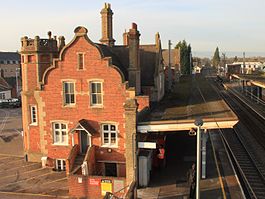Stowmarket railway station
| Stowmarket |
|
|---|---|

Stowmarket railway station in 2013
|
|
| Location | |
| Place | Stowmarket |
| Local authority | Mid Suffolk |
| Grid reference | TM051588 |
| Operations | |
| Station code | SMK |
| Managed by | Abellio Greater Anglia |
| Number of platforms | 2 |
| DfT category | C2 |
| Live arrivals/departures, station information and onward connections from National Rail Enquiries |
|
| Annual rail passenger usage* | |
| 2011/12 |
|
| 2012/13 |
|
| 2013/14 |
|
| 2014/15 |
|
| 2015/16 |
|
| History | |
| Key dates | Opened 1846 |
| National Rail – UK railway stations | |
| * Annual estimated passenger usage based on sales of tickets in stated financial year(s) which end or originate at Stowmarket from Office of Rail and Road statistics. Methodology may vary year on year. | |
|
|
|
Stowmarket railway station is on the Great Eastern Main Line (GEML) in the East of England, serving the town of Stowmarket, Suffolk. It is 80 miles 46 chains (129.7 km) down-line from London Liverpool Street and is situated between Needham Market to the south and Diss to the north. It is also the junction where the Ipswich to Ely Line joins the GEML. Its three-letter station code is SMK.
The station is currently operated by Abellio Greater Anglia, which also runs all trains serving the station.
The station was opened by the Ipswich & Bury Railway in 1846 with red brick main buildings in a flamboyant Jacobean manner by Frederick Barnes.
Building the railway from Ipswich to Bury St Edmunds proved challenging. When the Eastern Union Railway opened the line to Ipswich Stoke Hill railway station in 1846 this was located south of the existing tunnel. The Ipswich and Bury Railway built the tunnel which proved a challenge and then a further challenge awaited the railway’s engineers at Stowmarket area where local marsh swallowed up a lot of material with test probes finding the bog was 80 feet deep! The railway employed George Stephenson’s solution for the Chat Moss bog (a mere 40 feet deep) and a raft of brushwood and faggots was used to give the embankment a firm footing. The River Gipping was also diverted to aid the project.
On 26 November 1846 the first test train ran to Bury St Edmunds with stops at most stations on the route, accompanied by the inevitable lavish celebrations. The official opening followed on 7 December 1846 when a special train ran from Shoreditch (later Bishopsgate railway station) to a temporary station at Bury St Edmunds. The Board of Trade inspection took place on the 15 December 1846 and the line opened for traffic on 24 December.
The IBR and the EUR (they shared most of the directors anyway) were worked as one concern from 1847 and the following year the line from Haughley Junction (just north of Stowmarket) and Norwich opened in stages: from Haughley to Finningham (4 miles) on 7 June 1848, from Finningham to Burston (11 miles) on 2 July 1849 and finally through to Norwich Victoria (18½ miles) on 1 December 1849. Stowmarket now had links to Bury St Edmunds and Norwich.
...
Wikipedia
